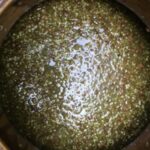Anh đi, anh nhớ quê nhà
Nhớ canh rau muống, nhớ cà dầm tương
(Folk-song)
Soybean sauce is a food that has been associated with the cultural and culinary life of Vietnamese people for generations. Soybean sauce is a common daily dish, any home can make a jar of soybean sauce for year-round use, which is both healthy, delicious, nutritious, cheap, used as an additive to many dishes such as Braised fish with soybean sauce, Tofu dipped with soybean sauce, braised black fillings with soybean sauce, water spinach with soybean sauce, Vietnamese eggplants pickled with soybean sauce, burnt veal with ginger sauce, etc.
Referring to soybean sauce, many people immediately think of soybean sauce made in Nam Dan (Nghe An), La (Bac Giang), Ban (Hung Yen), Mong Phu (Son Tay town) and Cu Da (Thanh Oai). There is also a village making soybean sauce for many generations, namely Duc Noi soybean sauce g village, Viet Hung commune, Dong Anh district. Legend has it that in the 3rd century BC, when An Duong Vuong built Co Loa citadel, present-day Viet Hung was an outpost protecting the northern gate. People did agriculture and handicrafts, with several traditional occupations such as: soy sauce, tofu, green square sticky rice cakes (banh chung), rice cakes (banh te), pork mince rice cakes (banh cuon), and rice paper wrappers (banh da). Over the centuries, Duc Noi village now only maintains the profession of making soybean sauce and rice cakes. Famous throughout the Kinh Bac region and the Thang Long period from time immemorial, Duc Noi soybean sauce is fragrant, delicious, sweet, and fleshy, blended from sticky rice, soybeans, and well water – simple ingredients of suburban farmers. Good tương depends on many factors: Mold, beans, water, salt, and container. With Duc Noi soybean sauce, in addition to the secret of brewing soybean sauce passed down from generation to generation, the most important stages are water and rice. Duc Noi soybean sauce is taken from wells in the village such as Mai well, Quang well, and Dong well. The reason for using open well water is because Duc Noi is on high ground, the wells are very deep, well water is very clear, cool and sweet. Although there is tap water, the people of Duc Noi still keep the traditional well to make soybean sauce.
“Nước giếng Dục Nội vừa trong, vừa mát
Đường cái Dục Nội lắm cát dễ đi”.
(Folk-song)
Besides, the stage of choosing rice is very important. It must be Thuy Lam roundgrain glutinous rice, Dong Anh district. The soil has endowed Thuy Lam with a delicious, rich, and full-grain glutinous rice variety, so when the food is cooked, the sticky rice seeds are shiny, flexible, and fragrant. After washing the rice, let the rice drain the water, then steam it. Ripe sticky rice will be poured into nia, thinned and then dried in a dry, airy place for a week, then the sticky rice seeds will have a yellow mold like areca flowers, that’s the standard.
In addition to rice, water is considered the most important, Duc Noi people are also picky about soybeans. That is domestic soybeans with yellow skin, green flesh. Soybeans are soaked in well water, drained, dried, roasted until golden brown, crispy, cooled, then crushed in half (only broken soybeans are used, do not use broken soybeans). Duc Noi people are still strict in choosing the container for soy sauce.
According to Mrs. Nguyen Thi Sam – a famous soy sauce maker in the village, the container must be an old fired jar. After being washed, the jars are rubbed with sea salt inside and then dried in the sun, wiped clean and then used to brew soy sauce, and then soy sauce is dried in the sun (called ngả tương) until “ripe” sauce is edible. Finished products are shaken, blending between the yellow color of the crushed-in-half beans and the musty green color, creating a unique color and flavor unlike any other.
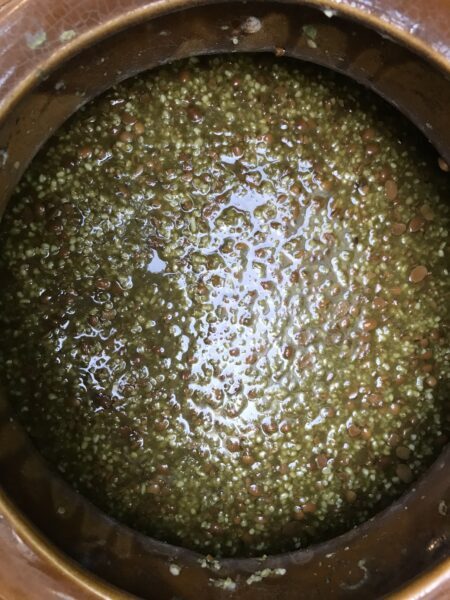
Tuong Duc Noi soybean sauce is fragrant, delicious, sweet
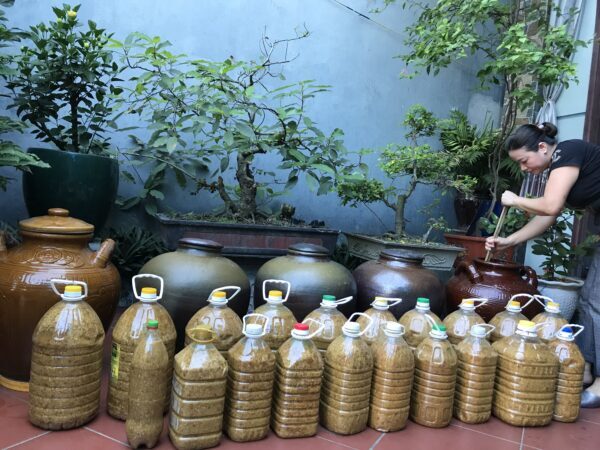
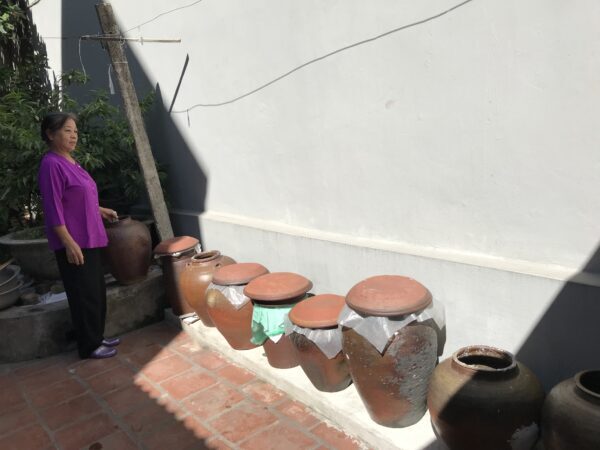
Some traditional soybean sauce production facilities in Duc Noi
(photo taken before the outbreak of COVID-19)
In Duc Noi village, most families know how to make soybean sauce. In the past, the whole Duc Noi village was like a factory area with many soy sauce production facilities, every day exporting thousands of liters to the market. If you are a connoisseur of soy sauce, you can tell the difference between Duc Noi and other types of soy sauce. Duc Noi sauce is consumed everywhere, in many restaurants in Hanoi, in Bac Ninh, Bac Giang, Lao Cai, Vinh Phuc, and Binh Duong provinces. Soy sauce is also sold in Doc market, To market, markets in Dong Anh district and is the main source of income for people, for a long time, etc. Now, due to objective factors, traditional soybean sauce products of craft villages are generally consumed slowly, so in Duc Noi village, there are only a few dozen households making soy sauce for sale in the domestic market, participating in trade fairs and exhibitions or as a gift for guests going abroad. Mrs. Sam’s and Mrs. Dong’s family have had 5 generations of professions, other families also have several generations of occupations. In addition to Mrs. Huu Thi Dong’s family, Ms. Nguyen Thi Sam, also the families of Ms. Thao, Ms. Binh, Ms. Dung, Mr. Truong, etc. are still enthusiastic about the profession.


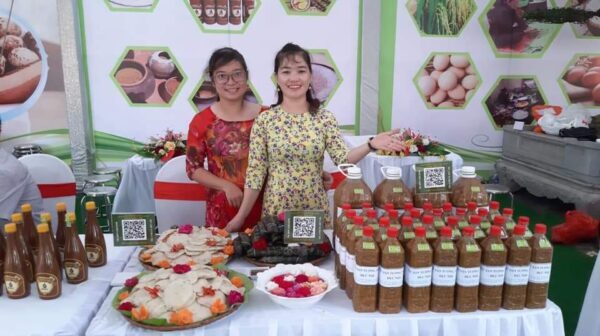
Duc Noi – Viet Hung soy sauce products are displayed and sold at a fair
Photo: Viet Hung Commune Women’s Union, photo taken before the outbreak of COVID-19
Respecting the traditional craft of the homeland, the leader of Viet Hung commune and local departments, agencies and mass organizations have many solutions to preserve and promote the traditional profession so that not only Duc Noi but many other villages can do the job, keep the traditional profession. At the end of 2020, the traditional craft of making soy sauce here was issued by the Hanoi People’s Committee Decision No. 5215/QD -UBND dated November 20, 2020, recognizing the collective trademark of Viet Hung soybean sauce. In December 2020, the National Office of Intellectual Property of Vietnam also issued a decision to recognize the collective trademark of Viet Hung. From here, the traditional soy sauce makers in Duc Noi village, Viet Hung commune have been assured of their craft and have high hopes for the output of their homeland’s products.
Thanh Quy

